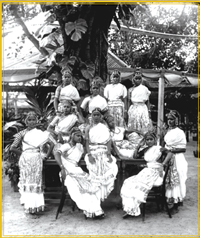|
Lakshmi Viswanathan is a multi-faceted personality. She is a renowned dancer and choreographer and excels in lecture-demonstrations, making the classical arts accessible to everybody. She is also a well-received writer, the author of Bharatanatyam: The Tamil Heritage, Kapaliswara Temple, and Kunjamma: Ode to a Nightingale (a pictorial biography of M.S. Subbulakshmi).

Women Of Pride: The Devadasi Heritage by Lakshmi Viswanathan, The Lotus Collection, Roli Books, Delhi. 210 pages, Rs. 295. |
Women of Pride, her latest book, is on the Devadasi tradition, the contribution of the Devadasis, and their background. At the end of the book, Lakshmi pays a moving tribute to their heritage. As she says in the introduction, “The Devadasi was the proverbial ‘dancing girl’ of India. Her name immediately suggests the two worlds she inhabited – that of gods and slaves. She served god and men, who assumed godly status as a slave (Dasi), and deemed it an honour to do so. The persona of the god changed over time. First he was the all powerful deity worshipped in the temple. Later he was the ‘king’ who was attended to by elaborate ceremony. Gradually, the king too became god, and demanded divine rights. The Devadasi shifted through these vicissitudes of temple, court and social life, unfaltering in her trained steps. She had become an expert in music, dance and a host of other ‘kalas’ (arts) which included the art of Love. She passed on her skills to generations of her daughters who left their mark on history as cultured women. The Devadasi, the only ‘educated’ woman of ancient Indian society, was a precious gem (‘Manikkam’) of the royal crown. Her pride was not merely in her attainments, but in her innate sensuality. Her expertise in dance and music matched her skills in the art of erotica. With God and king as her chief patrons, she grew in stature and took great pride in her heritage.”
Lakshmi has been dancing from her childhood and her vocation is her passion. She has studied the art form in all its aspects. From the time she was taught a sensuous padam by her dance teacher Kousalya, as a child, she has been fascinated by the music of dance. But she never encountered a Devadasi nor was the term ever mentioned in her presence. As she grew older, she learnt to understand and interpret the song as it should be. It was a piece relating to the Devadasi who, however, remained a somewhat mysterious and elusive figure to Lakshmi.
She explains, “From my view-point as a life-long dancer, I searched for the Devadasi who would be more real than a mysterious legend. However, her long history, which is inter-twined with religion, mythology, and social politics, posed a mind-boggling complexity. Fortunately I had the opportunity to see the human face of the last of the Devadasis. My involvement in dance and my understanding of what it meant to the generations of dancers who preceded me, helped me to approach the Devadasi with a mixture of reverence, disbelief and affection. I respected the finesse of her art. I could not believe that in spite of an immeasurably long history, the Devadasi who I came face to face with had reached the end of her existence. Without exception, those I met were warm, charming, intelligent women. There seemed to be an enigmatic femininity about them which I had not seen in other women. Mingled with an ethnic style, their personality suggested a natural gift of attraction. Their flair for dance and music was natural. They were very proud of their artistic legacy.
“A panoramic perspective of the Devadasi of South India and her life in different times, would throw light on the unique legacy of a unique kind of woman. Like the Geisha of Japan, she had a distinctive place in society until modernity displaced her and brought to naught the decisive part she played in fostering our culture. To evaluate her contribution to the arts and to understand the traditions of performance to which she was central, one must recognise the core principles of Hinduism. It was a way of life which gave credence to the concept of a timeless, yet ever-changing manifestation of devotion (Bhakti) directed to a many-faceted Supreme Being. To be a slave of God was the ultimate goal, of all human devotees, and more particularly of the dancer and singer - the Devadasi.”
Lakshmi delves into the social, religious and political reasons for their existence. She explains their once elevated status in society and their eventual downfall. She has sprinkled her text with interesting anecdotes from the Devadasis’ lives, as well as with a lot of historical facts.
Women of Pride is a book for the scholar and also the lay person. It is also a book with wonderful photographs, some from her own collection and some from other collectors.
For anybody interested in our colourful and artistic past and its influence on our present, this book is a must.
|